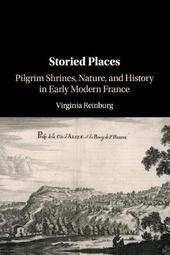
|
Storied Places: Pilgrim Shrines, Nature, and History in Early Modern France
Paperback / softback
Main Details
| Title |
Storied Places: Pilgrim Shrines, Nature, and History in Early Modern France
|
| Authors and Contributors |
By (author) Virginia Reinburg
|
| Physical Properties |
| Format:Paperback / softback | | Pages:273 | | Dimensions(mm): Height 230,Width 153 |
|
| Category/Genre | Christian worship, rites and ceremonies |
|---|
| ISBN/Barcode |
9781108716390
|
| Classifications | Dewey:263.04244 |
|---|
| Audience | | Professional & Vocational | |
|---|
| Illustrations |
Worked examples or Exercises; 6 Maps; 47 Halftones, black and white; Worked examples or Exercises; 6 Maps; 47 Halftones, black and white
|
|
Publishing Details |
| Publisher |
Cambridge University Press
|
| Imprint |
Cambridge University Press
|
| Publication Date |
11 June 2020 |
| Publication Country |
United Kingdom
|
Description
Pilgrim shrines were places of healing, holiness, and truth in early modern France. By analyzing the creation of these pilgrim shrines as natural, legendary, and historic places whose authority provided a new foundation for post-Reformation Catholic life, Virginia Reinburg examines the impact of the Reformation and religious wars on French society and the French landscape. Divided into two parts, Part I offers detailed studies of the shrines of Sainte-Reine, Notre-Dame du Puy, Notre-Dame de Garaison, and Notre-Dame de Betharram, showing how nature, antiquity, and images inspired enthusiasm among pilgrims. These chapters also show that the category of 'pilgrim' included a wide variety of motivations, beliefs, and acts. Part II recounts how shrine chaplains authored books employing history, myth, and archives in an attempt to prove that the shrines were authentic, and to show that the truths they exemplified were beyond dispute.
Author Biography
Virginia Reinburg is an Associate Professor of History at Boston College. She is the author of French Books of Hours: Making an Archive of Prayer, c.1400-1600 (Cambridge, 2012), and many articles on the religious and cultural history of early modern France.
Reviews'Virginia Reinburg provides a profoundly empathetic yet incisive reading of the ways in which communities which had suffered so much during the French religious wars managed to defend and refurbish their archives of faith. This is a masterpiece of the historian's craft: both utterly compelling and deeply moving.' Simon Ditchfield, University of York 'Virginia Reinburg's study of shrines in early modern France paints them into the landscape of healing powers, mythic origins, and local forces. Her well-documented case studies tell the story of the powerful wellsprings of belief that the Protestant Reformation had contested, but that Catholic revival successfully reinvigorated.' Mark Greengrass, University of Sheffield 'Storied Places masterfully illuminates the important role that pilgrimage shrines played in the Catholic renewal that took place in the wake of France's Wars of Religion. As Virginia Reinburg persuasively demonstrates, the apparitions and miracles reported at these shrines, marrying grace to nature, re-affirmed Catholic truths in places where the church and its truths had been most contested. Reinburg's nuanced examination of the shrines as products of both place and story makes a strikingly original contribution to our understanding of early modern religious culture.' Barbara Diefendorf, Boston University 'Storied Places is a compelling investigation of how pilgrimage shrines were remade, materially and mentally, in the wake of the French Wars of Religion. Bringing the histories of text and territory, authority and archive, into creative dialogue, Virginia Reinburg offers fresh insight into how early modern Catholicism overcame the challenges of iconoclasm, discord, and doubt. Her book persuasively recasts our understanding of the relationship between sacred landscapes and religious truth in the Counter-Reformation world.' Alexandra Walsham, University of Cambridge 'What happened to pilgrimage, that quintessential medieval activity of Catholic worship, after the advent of the Reformation and the shock of Protestant iconoclasm? Reinburg traces the renewal and growth of pilgrim shrines in early modern France, emphasizing their relations to the natural world, their ancient but sometimes mythic origins, and their powers to heal and inspire. ... Those sites that survived the violence of the religious wars faced a new challenge, as writers strove to counter doubts about religious truth with assertions of these shrines' antiquity and authenticity. The 'shrine books' that resulted combined myth, history, and archives to counter iconoclasm, oblivion, and doubt. The works and their authors employed print culture to convince those shaken by religious turmoil that the Catholic Church possessed the one true faith.' L. C. Attreed, Choice 'The author helps her readers to understand the impact of the religious wars on Catholic survivors. Reinburg thoughtfully highlights the ordeal Catholic communities faced and their efforts to avoid confronting trauma in future generations by creating and recreating shrines. She convincingly asserts that the rebuilding of structures and communities was a way for Catholics to tell a story of their history that was coherent and could overlook the religious wars ... What makes Reinburg's book so engaging is its multifaceted approach to telling the history of the shrines and the regions she studies.' Susan E. Dinan, H-France Review 'This is an excellent book which merits a wide readership. It displays deep scholarship, sophisticated use of a wide range of sources including site visits - which are illustrated - and it is written with clarity and gracefulness. It is a seminal essay, which makes one reflect on spirituality and landscape in new ways.' Elizabeth Tingle, The Journal of Ecclesiastical History '... an illuminating exploration of how the appeal of significant shrines was constructed and maintained, with insights as well into what the experience of visiting these places as a pilgrim might have been like.' Philip Benedict, Journal of Modern History
|